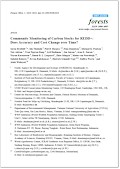| Journal Article |
 |
|
| Article Title | Community Monitoring of Carbon Stocks for REDD+: Does Accuracy and Cost Change over Time? | | Author | Søren Brofeldt, Ida Theilade, Neil D. Burgess, Finn Danielsen, Michael K. Poulsen, Teis Adrian, Tran Nguyen Bang, Arif Budiman, Jan Jensen, Arne E. Jensen, Yuyun Kurniawan, Simon B. L. Lægaard, Zhao Mingxu, Meine van Noordwijk, Subekti Rahayu, Ervan Rutishauser, Dietrich Schmidt-Vogt, Zulfira Warta and Atiek Widayati | | Year | 2014 | | Journal Title | Forests | | Institution | MDPI AG (Basel, Switzerland) | | Volume | 5 | | Pages | 1834-1854 | | Call Number | JA0583-14 | | Keywords | climate change; community based management; forest carbon; governance; participatory monitoring; REDD+ readiness; safeguards; tropical forest |
|
| Abstract: |
| Reducing emissions from deforestation and forest degradation in developing
countries, and the role of conservation, sustainable management of forests, and
enhancement of forest carbon stocks in developing countries (REDD+) is a potentially
powerful international policy mechanism that many tropical countries are working towards
implementing. Thus far, limited practical consideration has been paid to local rights to
forests and forest resources in REDD+ readiness programs, beyond noting the importance
of these issues. Previous studies have shown that community members can reliably and
cost-effectively monitor forest biomass. At the same time, this can improve local
ownership and forge important links between monitoring activities and local
decision-making. Existing studies have, however, been static assessments of biomass at
one point in time. REDD+ programs will require repeated surveys of biomass over
extended time frames. Here, we examine trends in accuracy and costs of local forest
monitoring over time. We analyse repeated measurements by community members and
professional foresters of 289 plots over two years in four countries in Southeast Asia. This
shows, for the first time, that with repeated measurements community members’ biomass
measurements become increasingly accurate and costs decline. These findings provide
additional support to available evidence that community members can play a strong role in
monitoring forest biomass in the local implementation of REDD+. |
|